Red Cherry Shrimp - Comments and Pics
Moderator: Mustafa
-
chlorophyll
- Shrimp

- Posts: 218
- Joined: Wed Feb 16, 2005 1:22 am
- Location: Hawaii - USA
Hi GB,
I would think their sizes won't differ much in the end either. Are they becoming similar in color? It was the smaller one that was super red, right? So the larger one is deepening?
Mustafa uses a pic on his aquabid auctions with an extremely red female like yours.
http://www.petshrimp.com/files/superredcherry.jpg
I wonder if he has some insight as to whether this is a breedable trait, or just a variable coloration occurence.
I would think their sizes won't differ much in the end either. Are they becoming similar in color? It was the smaller one that was super red, right? So the larger one is deepening?
Mustafa uses a pic on his aquabid auctions with an extremely red female like yours.
http://www.petshrimp.com/files/superredcherry.jpg
I wonder if he has some insight as to whether this is a breedable trait, or just a variable coloration occurence.
I have several of those "Supperred" shrimp. I am currently trying to selectively breed them, but it's still early in the game. I'll update the forum and the Shrimp Varietes section once I have some more reliable results. Early results indicate that the extreme red coloration is a combination of genes and food.
- GunmetalBlue
- Shrimpoholic

- Posts: 263
- Joined: Sat Apr 16, 2005 11:10 am
- Location: CA
Wanted to mention that concerning color in an adult Red Cherry, I think of a distinction between the actual "shade" of red and the actual "coverage" of red. Very generally speaking, my personal observation has been that the "shade" may be determined more often by pregnancy, mood, food, lighting and other such outside factors.
The actual red color "coverage" (meaning less clear areas), I tend to think as being determined more by genetics (just my opinion), although food and environment would enhance their ability to reach their color coverage potential. I'm looking forward to one day hearing results and opinions, those of you trying out some super red combinations.
Something I've noticed is, my Cherries really love and go after the darkest green, almost black colored algae. Just a suspicion, but I *think it might be partially responsible for the redder color. I've mentioned before that due to my large supply of algae, my Cherries tend to ignore store-bought food.
However, it doesn't explain why my male Cherry is practically colorless - genetics? Or perhaps that's just the way males should be? For he has the same food/environment the red females have. I wish I knew more about genetics, but unfortunately it's a dry topic for me; I'm more interested behavior. Sooo... I Hope this isn't too dumb a question, but is there such a thing as color being sex related? Meaning the color gene is closely linked to red for females, colorless for males? I would think the determining factor would be in choosing the reddest (in coverage) female, no? Or does it need to be the reddest female and the reddest male to produce super red females? Eek! I probably didn't make any sense.
Update: Originally I had stated that after the eggs hatch, they molt, mate and start the process over again. I now realize it's a bit more complex than that because after the "supersized" female's eggs hatched, she did molt - however would not allow mating. Perhaps she wanted to skip a cycle and rest to allow the stores in her ovaries to completely replenish itself? She does have a saddle (which slowly reforms while carrying eggs in their pleopod), but it had not yet returned to being quite as large as the first time around.
-GB
The actual red color "coverage" (meaning less clear areas), I tend to think as being determined more by genetics (just my opinion), although food and environment would enhance their ability to reach their color coverage potential. I'm looking forward to one day hearing results and opinions, those of you trying out some super red combinations.
Something I've noticed is, my Cherries really love and go after the darkest green, almost black colored algae. Just a suspicion, but I *think it might be partially responsible for the redder color. I've mentioned before that due to my large supply of algae, my Cherries tend to ignore store-bought food.
However, it doesn't explain why my male Cherry is practically colorless - genetics? Or perhaps that's just the way males should be? For he has the same food/environment the red females have. I wish I knew more about genetics, but unfortunately it's a dry topic for me; I'm more interested behavior. Sooo... I Hope this isn't too dumb a question, but is there such a thing as color being sex related? Meaning the color gene is closely linked to red for females, colorless for males? I would think the determining factor would be in choosing the reddest (in coverage) female, no? Or does it need to be the reddest female and the reddest male to produce super red females? Eek! I probably didn't make any sense.
Hi Chlorophyll, yes, the less red female has aquired more color coverage, though not quite as much as the smaller "super red." The super red one is pregnant, so she's intensely red. I consider them to be fully mature adults now - and their size difference is significant, so I'm tending to believe the super red one will stay on the dainty side. I'll just call the larger one, the "supersized" one, lol.I would think their sizes won't differ much in the end either. Are they becoming similar in color? It was the smaller one that was super red, right? So the larger one is deepening?
Update: Originally I had stated that after the eggs hatch, they molt, mate and start the process over again. I now realize it's a bit more complex than that because after the "supersized" female's eggs hatched, she did molt - however would not allow mating. Perhaps she wanted to skip a cycle and rest to allow the stores in her ovaries to completely replenish itself? She does have a saddle (which slowly reforms while carrying eggs in their pleopod), but it had not yet returned to being quite as large as the first time around.
-GB
-
chlorophyll
- Shrimp

- Posts: 218
- Joined: Wed Feb 16, 2005 1:22 am
- Location: Hawaii - USA
I'm not genetics/breeding expert myself, but you can see in guppies for example that long fins and colorful bodies are only really necessary in fancy guppy males for the offspring males to also have the traits. Fancy guppy females generally look just like wild guppy females except with more color in their tails. So yeah, coloration patterns can be sex-linked.
Yeah, sex-linked is the term I think. There may also be traits that one sex is responsible for passing on, yet the trait is only visible in the other sex. Is male pattern baldness one like that? I think I've heard that men actually get that trait from mom. I really don't know, that might be a myth!
As for your turnover rate, I'm not use to noticing new eggs immediately after a female's eggs hatch (of ourse it can be hard to keep track). So I always kind of assumed females take a little time off after broods. Depends on how well fed and unstressed they are though (not that it would mean your shrimp is suffering jus tbecause she didn't produce new eggs immediately). I had one female prawn being kept alone (first time I was keeping the species and she killed all her brothers and sisters) and well fed. She'd produce eggs after every moult, all by herself like that. Poor girl, so lonely. She should have kept one of her brothers alive so she could have incestuous affairs.
Yeah, sex-linked is the term I think. There may also be traits that one sex is responsible for passing on, yet the trait is only visible in the other sex. Is male pattern baldness one like that? I think I've heard that men actually get that trait from mom. I really don't know, that might be a myth!
As for your turnover rate, I'm not use to noticing new eggs immediately after a female's eggs hatch (of ourse it can be hard to keep track). So I always kind of assumed females take a little time off after broods. Depends on how well fed and unstressed they are though (not that it would mean your shrimp is suffering jus tbecause she didn't produce new eggs immediately). I had one female prawn being kept alone (first time I was keeping the species and she killed all her brothers and sisters) and well fed. She'd produce eggs after every moult, all by herself like that. Poor girl, so lonely. She should have kept one of her brothers alive so she could have incestuous affairs.
-
Mihai Victor
- Egg

- Posts: 4
- Joined: Wed Jun 15, 2005 1:16 pm
- Location: Romania/Bucuresti
- GunmetalBlue
- Shrimpoholic

- Posts: 263
- Joined: Sat Apr 16, 2005 11:10 am
- Location: CA
Hey thanks, Mihai! 
Chlorophyll, the guppy example is exactly the kind of thing I was thinking about. I've heard the same as you concerning male pattern baldness; I've also heard it skips a generation (don't know if that's true). So those are very weird variables. Whenever there are unexpected variations, it can take some time to sort out what the correct parameters to pursue are.
There was a person I spoke to once who was really into - I guess it's logistics? Anyway, he was explaining that if one happens to choose one wrong factor or parameter and place too much importance on it, it can completely skew up your research and take that much longer to reach the appropriate conclusion because that particular factor may have nothing to do with whatever conclusion you're trying to draw. So unless you're working with things that are already proven to be true - which can save you some time, one is stuck with a lot of trial and error at first.
I'm getting a variety of things going on with my shrimp, such as the one Cherry deciding to have eggs right after a hatching and a molt; whereas the other did not, so I'm getting a chance to learn more quickly, the variety of things that can be expected.
Yes, what is it with anti-social shrimp? I had two M. lanchesteri, my first shrimps, which were doing great... then one killed the other. I was so bummed and really wish I could have foreseen it and have done something to prevent it. So now I just tell others to be aware their Macrobrachiums are capable of doing some damage. My two females used to have eggs too (without a male), and continued to do so for about 4 cycles. Of course they were always dropped. After that, they stopped having eggs.
Update: I counted 20 Cherry shrimplets in one sitting, so I figure I have at least that, and probably more! They are all of varying sizes and they all look like "Daddy," since they don't have any color on them yet.
They are all of varying sizes and they all look like "Daddy," since they don't have any color on them yet.
Thought I'd add an amusing(?) anecdote about how my original 5 Cherries, of which two later died, (though not because of the following incident) were brought home: One weekend on a recreational bicycle ride, we decided to stop at a semi-LFS about 6 miles away, to pick up some plants. Lo and behold, the store had a small batch of Red Cherries! I was so afraid they would be gone by the time I could get home then drive back to get them, that I bought them right then and there... so they rode home in a bag suspended from the handlebar, gently swinging and yes, they had a sprig of plant to hold on to. If I'm not mistaken, not too many Red Cherries can claim to have gone on a bike ride.
-GB
Chlorophyll, the guppy example is exactly the kind of thing I was thinking about. I've heard the same as you concerning male pattern baldness; I've also heard it skips a generation (don't know if that's true). So those are very weird variables. Whenever there are unexpected variations, it can take some time to sort out what the correct parameters to pursue are.
There was a person I spoke to once who was really into - I guess it's logistics? Anyway, he was explaining that if one happens to choose one wrong factor or parameter and place too much importance on it, it can completely skew up your research and take that much longer to reach the appropriate conclusion because that particular factor may have nothing to do with whatever conclusion you're trying to draw. So unless you're working with things that are already proven to be true - which can save you some time, one is stuck with a lot of trial and error at first.
I'm getting a variety of things going on with my shrimp, such as the one Cherry deciding to have eggs right after a hatching and a molt; whereas the other did not, so I'm getting a chance to learn more quickly, the variety of things that can be expected.
Yes, what is it with anti-social shrimp? I had two M. lanchesteri, my first shrimps, which were doing great... then one killed the other. I was so bummed and really wish I could have foreseen it and have done something to prevent it. So now I just tell others to be aware their Macrobrachiums are capable of doing some damage. My two females used to have eggs too (without a male), and continued to do so for about 4 cycles. Of course they were always dropped. After that, they stopped having eggs.
Update: I counted 20 Cherry shrimplets in one sitting, so I figure I have at least that, and probably more!
Thought I'd add an amusing(?) anecdote about how my original 5 Cherries, of which two later died, (though not because of the following incident) were brought home: One weekend on a recreational bicycle ride, we decided to stop at a semi-LFS about 6 miles away, to pick up some plants. Lo and behold, the store had a small batch of Red Cherries! I was so afraid they would be gone by the time I could get home then drive back to get them, that I bought them right then and there... so they rode home in a bag suspended from the handlebar, gently swinging and yes, they had a sprig of plant to hold on to. If I'm not mistaken, not too many Red Cherries can claim to have gone on a bike ride.
-GB
super red
I also found the redness of cherries varied quite a lot. There are some "superred" cherries in my tank, which are almost pure blood red, no purple/dark hue at all. Those ones also show redness at a VERY young age.
Young adult:

Juvenile barely 1/2", notice the eggs in ovary are not even developed yet, but already showing quite a bit of redness, it will be a super red no doubt.

Young adult:

Juvenile barely 1/2", notice the eggs in ovary are not even developed yet, but already showing quite a bit of redness, it will be a super red no doubt.

- GunmetalBlue
- Shrimpoholic

- Posts: 263
- Joined: Sat Apr 16, 2005 11:10 am
- Location: CA
Hi Russell and welcome to the forum. Nice going, sounds like you've already got yourself a decent batch of super reds. 
Shalu, I agree, from what I've observed so far, super reds can show signs of it quite early. I had a similar situation with young shrimp. The one in my second pic (which I'll reproduce here for convenience) is young enough to still look like a male. But recall that my male is mostly clear, so this is a very young female (most likely the super red) without a saddle yet.
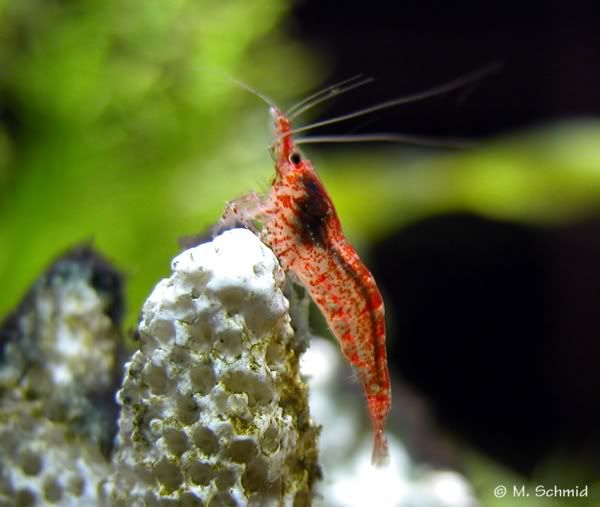
Here's the three of them a little older, but still haven't been pregnant yet; note the super red (out of focus in the background right) with much more red coverage than the female in the front.
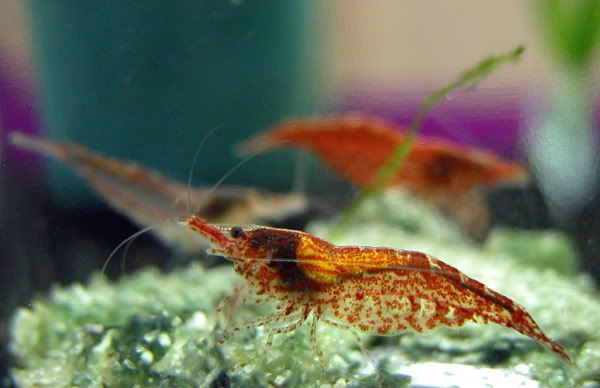
I think I will see in the next few months anything conclusive about the breeding, as I've lost that less red one due to a mini-disaster four days ago.
I woke up to see numerous baby shrimps racing around the tank, which told me the water quality had gone south. I assessed the situation and figured out that the plant that was in the mating picture (don't know the name of it) had been dying a slow death and was now fouling up the water. I painstakingly picked through each branch to make sure any shrimplets weren't hiding in it before tossing, then did a partial water change. I had previously cut back on my water change routine and any messing with the tank, due to shrimplets, but I definitely had to take action. Anyway, I lost that supersized female and one shrimplet that I could see.
During the event, it was painful watching the super red racing around the tank, flapping her pleopod madly - her eggs were due to hatch the next day and I worried she would lose them all. Fast forward to today, I've seen a good handful of newborn shrimplets, so thankfully she didn't lose babies.
Hey, if anyone has a well-colored red male that's definitely a male, please post pic. I'm curious as to how red males can get.
-GB
Shalu, I agree, from what I've observed so far, super reds can show signs of it quite early. I had a similar situation with young shrimp. The one in my second pic (which I'll reproduce here for convenience) is young enough to still look like a male. But recall that my male is mostly clear, so this is a very young female (most likely the super red) without a saddle yet.

Here's the three of them a little older, but still haven't been pregnant yet; note the super red (out of focus in the background right) with much more red coverage than the female in the front.

I think I will see in the next few months anything conclusive about the breeding, as I've lost that less red one due to a mini-disaster four days ago.
I woke up to see numerous baby shrimps racing around the tank, which told me the water quality had gone south. I assessed the situation and figured out that the plant that was in the mating picture (don't know the name of it) had been dying a slow death and was now fouling up the water. I painstakingly picked through each branch to make sure any shrimplets weren't hiding in it before tossing, then did a partial water change. I had previously cut back on my water change routine and any messing with the tank, due to shrimplets, but I definitely had to take action. Anyway, I lost that supersized female and one shrimplet that I could see.
During the event, it was painful watching the super red racing around the tank, flapping her pleopod madly - her eggs were due to hatch the next day and I worried she would lose them all. Fast forward to today, I've seen a good handful of newborn shrimplets, so thankfully she didn't lose babies.
Hey, if anyone has a well-colored red male that's definitely a male, please post pic. I'm curious as to how red males can get.
-GB
- GunmetalBlue
- Shrimpoholic

- Posts: 263
- Joined: Sat Apr 16, 2005 11:10 am
- Location: CA
Hi everyone, it's been about 4 or 5 months since originally posting this thread; hope you won't mind my updating their current situation.
I must say, RCS multiply fast! After the 5th batch of shrimplets (resulting in about 125 shrimplets total), I had to do something since I was starting to run out of room. I deliberated long and hard on different options and finally decided to slow them down by separating the offspring according to sex. So the only male and female together in a breeding tank is the super red and the original male (the pair that had been in the mating pic).
Got a pic of this RCS shrimplets minutes after it was born. The head still looks like an egg! Except now, with an unfurled tail:
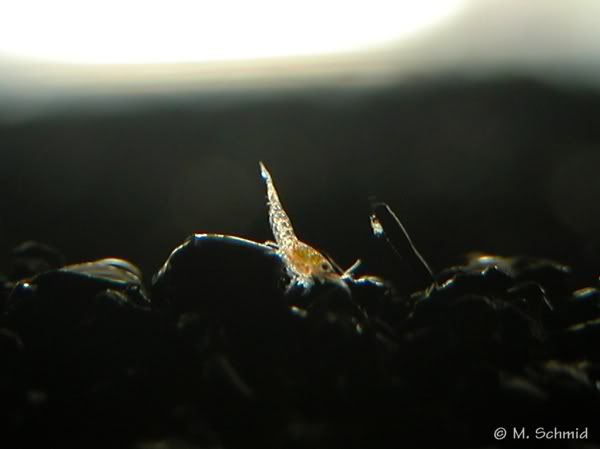
Juvenile:
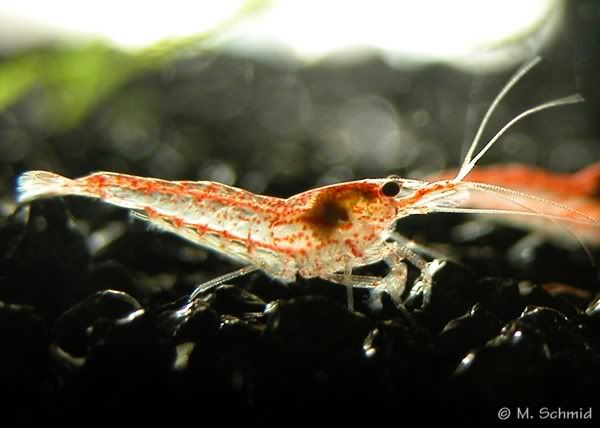
Scads of Juvies:
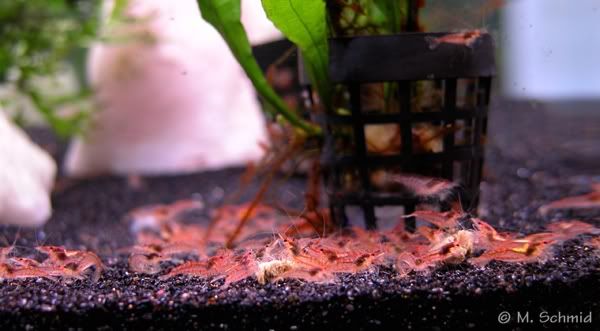
The original super red mom is still around:
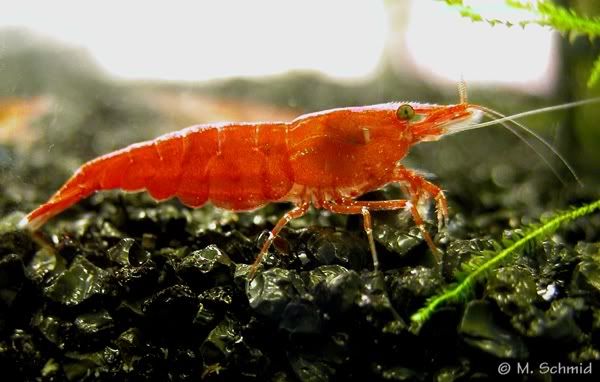
Snacking with Jr.:
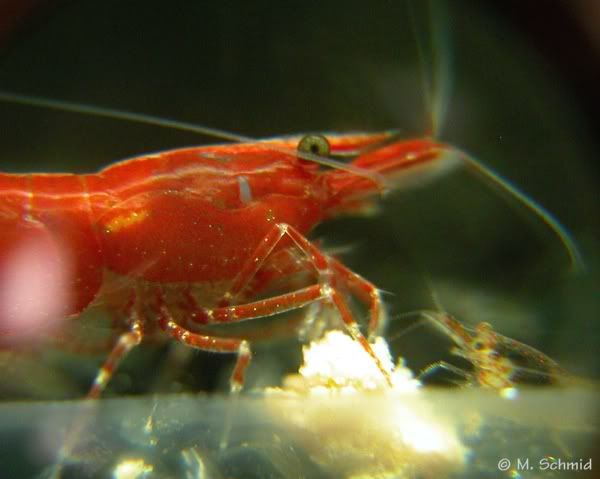
To explain what I have done in separating the shrimp by sex, I've turned my 20 gal into what I jokingly call my "All Female RC Shrimp Utopia." I'm embarrassed to show my tanks since they are all "no maintenance" tanks and not very exciting to look at so please bear with me - but I really like looking in there and seeing the little red ladies. Bet a male RCS would like to accidentally get put in there, eh?
I'm embarrassed to show my tanks since they are all "no maintenance" tanks and not very exciting to look at so please bear with me - but I really like looking in there and seeing the little red ladies. Bet a male RCS would like to accidentally get put in there, eh? 
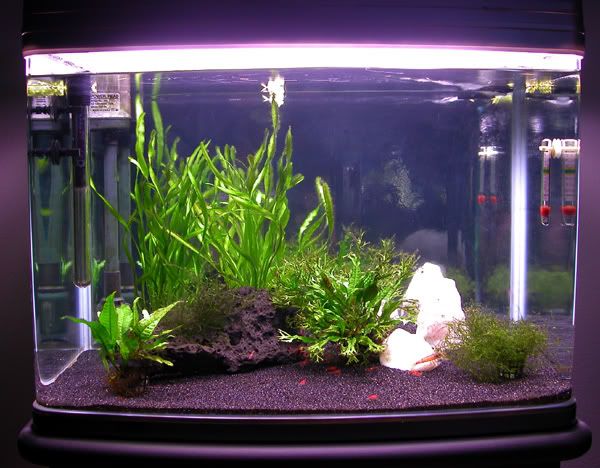
Feeding time:
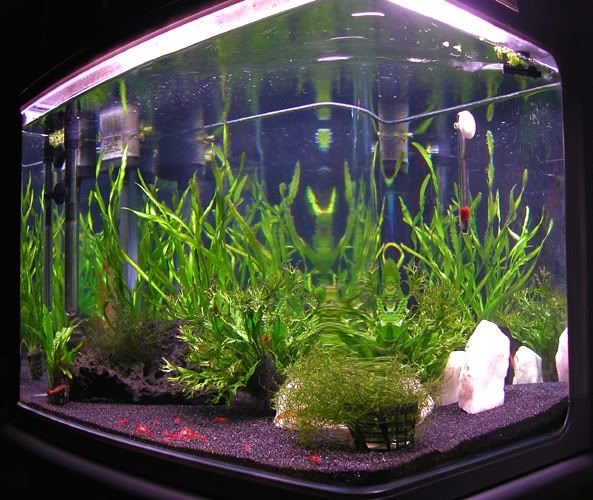
Front view:
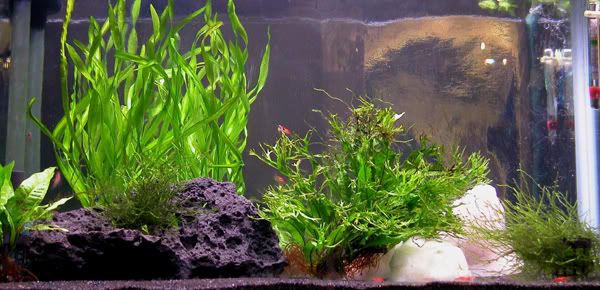
Detail:
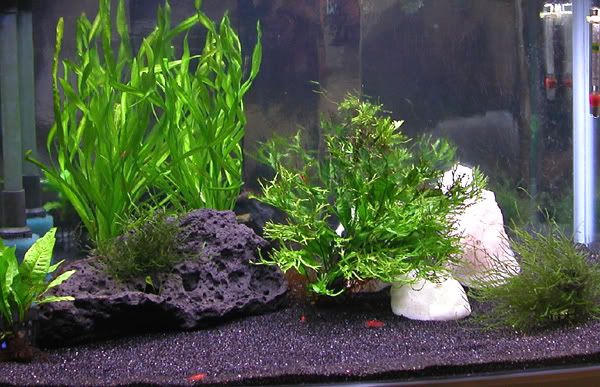
Detail:
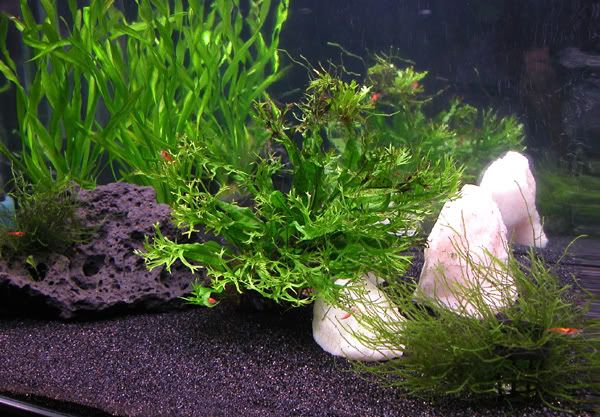
Here's one of the young females with unfertilized eggs; I wasn't at first entirely sure if RCS will carry eggs without fertilization (although I knew certain Macrobrachiums do) - now I know for sure they will, even if for a very short time. There was one that actually carried for 4 days and had me worried! I thought maybe a male was hiding in there with a disguise on (yellow paint, anyone?).
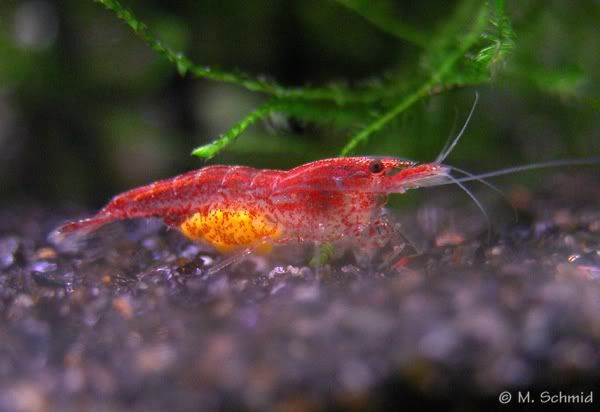
I haven't reached any conclusions yet concerning breeding for color; most of the growing females seem decently colored though 3 or 4 in particular stands out. I'm going to venture a guess as to say that out of a batch, you'll get the occasional really super red one, with the rest being reasonably well colored. Will have to wait until they are older.
Here are questions I've posed for myself, which may in time play out:
1.) After several cycles of having unfertilized eggs on their swimmerettes, will they stop, without the presence of males? And when they are put back in with a male after this process, will their ability to reproduce have been compromised?
2.) Since pregnancy seems to enhance the color of RCS, will the fact that most of these females won't ever get pregnant, affect reaching an optimal color?
3.) I've been trying to observe what causes color intensity or a lack thereof in RCS females. So far I have found substrate darkness plays a big role. I've also found RCS can vary in color intensity throughout the day. For mine, they seem to be the most colorful late at night when the tank lights have been on for a long time. Conversely, they seem most pale in the morning/early afternoons, when tank lights haven't been on - incidently, lights on from 2PM - 1AM. Not sure what they look like at the crack of dawn since I'm never awake then... I would guess less intense color?
4.) I notice their color is more intense during the time they have a larger saddle. After they've dropped the eggs and their saddle is at minimum, they are a little less intense. Also, RCS tend to be sexually mature long before they reach their full coloration.
If you've made other observations about RCS, please feel free to contribute!
-GB
I must say, RCS multiply fast! After the 5th batch of shrimplets (resulting in about 125 shrimplets total), I had to do something since I was starting to run out of room. I deliberated long and hard on different options and finally decided to slow them down by separating the offspring according to sex. So the only male and female together in a breeding tank is the super red and the original male (the pair that had been in the mating pic).
Got a pic of this RCS shrimplets minutes after it was born. The head still looks like an egg! Except now, with an unfurled tail:

Juvenile:

Scads of Juvies:

The original super red mom is still around:

Snacking with Jr.:

To explain what I have done in separating the shrimp by sex, I've turned my 20 gal into what I jokingly call my "All Female RC Shrimp Utopia."

Feeding time:

Front view:

Detail:

Detail:

Here's one of the young females with unfertilized eggs; I wasn't at first entirely sure if RCS will carry eggs without fertilization (although I knew certain Macrobrachiums do) - now I know for sure they will, even if for a very short time. There was one that actually carried for 4 days and had me worried! I thought maybe a male was hiding in there with a disguise on (yellow paint, anyone?).

I haven't reached any conclusions yet concerning breeding for color; most of the growing females seem decently colored though 3 or 4 in particular stands out. I'm going to venture a guess as to say that out of a batch, you'll get the occasional really super red one, with the rest being reasonably well colored. Will have to wait until they are older.
Here are questions I've posed for myself, which may in time play out:
1.) After several cycles of having unfertilized eggs on their swimmerettes, will they stop, without the presence of males? And when they are put back in with a male after this process, will their ability to reproduce have been compromised?
2.) Since pregnancy seems to enhance the color of RCS, will the fact that most of these females won't ever get pregnant, affect reaching an optimal color?
3.) I've been trying to observe what causes color intensity or a lack thereof in RCS females. So far I have found substrate darkness plays a big role. I've also found RCS can vary in color intensity throughout the day. For mine, they seem to be the most colorful late at night when the tank lights have been on for a long time. Conversely, they seem most pale in the morning/early afternoons, when tank lights haven't been on - incidently, lights on from 2PM - 1AM. Not sure what they look like at the crack of dawn since I'm never awake then... I would guess less intense color?
4.) I notice their color is more intense during the time they have a larger saddle. After they've dropped the eggs and their saddle is at minimum, they are a little less intense. Also, RCS tend to be sexually mature long before they reach their full coloration.
If you've made other observations about RCS, please feel free to contribute!
-GB

